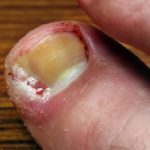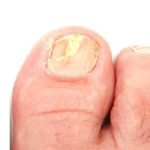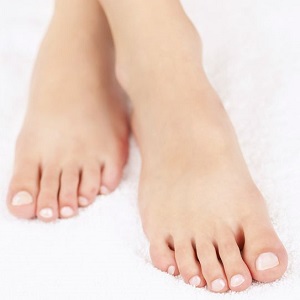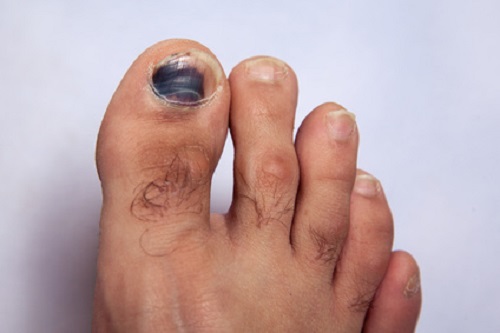When toenails don’t toe the line…
Pretty toenails in pink paint are every girls dream. Unfortunately if you’re a sweaty athlete, wear tight shoes all day or your work takes you to places where they are more like to pull out your toenails than paint them for you, toenail problems can arise pretty quickly.
The two most common toenail problems are:
1. Onychocryptosis or Ingrown toenails and
2. Onychomycosis or Fungal nails
Ingrown Toenails: Causes & Treatment
Ingrown Toenails are characterized by extremely painful toes that occur because a sharp corner of the toenail has dug into the skin at the side or end of the toe. Initially inflammation and pain are common. If the situation worsens, yellowish fluid along with growth of extra tissue can be seen.
Causes of Ingrown Toenails:
- This condition generally occurs because of downward or sideways pressure on the nail caused most often by wearing closed shoes that are too tight. The big toe is the one most commonly affected. The little toe nail can also be affected and are equally painful. Other causes include:
• Improper trimming of toenails.
• Repeated damage to the toenail like when playing a kicking or start-stop sport.
• Severe and sudden injury near the toenail or nail bed.
• Inheriting the tendency to ingrown toenails from a parent.
• Dampness due to sweating in closed shoes, softening the nail plate and swelling the surrounding fleshy skin.
Treatment of Ingrown Toenails:
- The first step is to discover and then prevent more damage.
• Find footwear with more space for your toes. Perhaps sandals or flip-flops if your activities allow. Bare feet can be really tempting. Keep in mind that keeping your feet clean is critical if the nail has pierced the skin.
• If caused by bad nail trimming, re-trimming the nail yourself may help. If you decide to do this, be very careful. It can make it worse.
• Soaking the affected area in quite warm salt water sometimes helps, but sometimes just makes everything soggy and more prone to infection
• Applying an antibacterial ointment or liquid may reduce the risk of infection.
• If you are in the middle of a really painful ingrown toenail episode, self-treatment sometimes makes it worse. This is the time to see a podiatrist for professional treatment.
• There has been a revival in the use of nail braces. This is an option that some podiatrists use.
• In severe cases, surgical intervention may become necessary. There are two main recognized methods. A podiatrist can guide your decision.
• Prevention remains the best approach
• To prevent recurrence of ingrown toenails it is important to trim the toenails in a straight line instead of a curve.
• Avoid damage
Fungal Nails: Causes & Treatment
Fungal nails are another common toenail problem that begin with white or yellow spots or streaks under and within the toenails. As the fungal nails become more severe, the area of nail discoloration increases, the nail may thicken, and start crumbling at the edges. It is uncommon to find multiple people in the same household with fungal nails, however care should be taken.
Hint…not all white or yellow spots are fungal. It can be a good idea to seek an opinion from a reputable podiatrist before commencing self treatment. Some toenails also appear black. Read more about black toenails
Causes of Fungal Nails:
- Fungal infections succeed in moist warm and dark areas
• Fungal infections are commonly transferred from moist, wet areas like communal gyms, showers, swimming pools.
• Also wearing tight fitting shoes and sweaty socks creates a warm, dark, moist atmosphere which is very conducive to the growth of fungus. This also explains why athletes are more prone to fungal nails.
• After showering, toenails hold a lot of moisture. If we put on our socks and shoes too quickly, the nails remain moist. The warmth and darkness inside the shoes is then ideal for the fungus to flourish
Treatment of Fungal Nails
- Prevention, prevention, prevention.
• Good nail hygiene that includes keeping the nails trimmed and filed can help prevent and reduce fungal nail infections.
• Allowing nails to dry thoroughly before putting on socks and shoes is essential
• If you already have an infected nail ignoring it is not recommended. It may spread.
• Creams and topical nail medications are available. Some require daily application and weekly filing. It’s a slow process but many people have found this method to be effective in treating fungal nails. Following the instruction is really important. They are not always successful.
• Sometimes the podiatrist may shave off the top layer of the nail or even remove part of the nail most infected. This, with a topical application or laser therapy may be effective.
• Oral anti-fungal drugs may be more effective than topical medications
• In severe cases the podiatrist recommend removing the nail completely by a small surgical procedure.
• An unaffected nail, no matter which treatment, may take a year to grow through fully. So patience and perserverence are required. But it is worth it.
Prevention of Toenail Related Problems
While both – ingrown toenails and fungal nails – are not the most severe of feet related problems, they can cause great discomfort. Also, they are very easy to prevent with a little bit of precaution and proper foot care.
• Wash and dry your feet before bed.
• Wear sandals or roomy footwear that allows plenty of ventilation and space for your feet to breathe.
• If your shoes get wet, let them dry thoroughly before you wear them again.
• Dry your feet thoroughly after using wet public areas like locker rooms.
• Trim your nails carefully and regularly.
• At the first sign of any toenail related problems, take cautionary care at home or head to the podiatrist.
Which path for your feet




